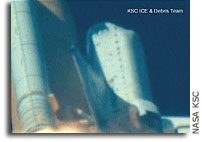Columbia Accident Investigation Board Statement

For all those who are inspired by flight, and for the nation
where powered flight was first achieved, the year 2003 had
long been anticipated as one of celebration – December 17
would mark the centennial of the day the Wright Flyer first
took to the air. But 2003 began instead on a note of sudden
and profound loss. On February 1, Space Shuttle Columbia
was destroyed in a disaster that claimed the lives of all seven
of its crew.
While February 1 was an occasion for mourning,the efforts
that ensued can be a source of national pride. NASA publicly
and forthrightly informed the nation about the accident and
all the associated information that became available. The Co-
lumbia Accident Investigation Board was established within
two hours of the loss of signal from the returning spacecraft
in accordance with procedures established by NASA follow-
ing the Challenger accident 17 years earlier.
The crew members lost that morning were explorers in the
finest tradition, and since then, everyone associated with the
Board has felt that we were laboring in their legacy. Ours,too,
was a journey of discovery: We sought to discover the conditions that produced this tragic outcome and to share those
lessons in such a way that this nation’s space program will
emerge stronger and more sure-footed. If those lessons are
truly learned, then Columbia’s crew will have made an indelible contribution to the endeavor each one valued so greatly.
After nearly seven months of investigation, the Board has
been able to arrive at findings and recommendations aimed
at significantly reducing the chances of further accidents.
Our aim has been to improve Shuttle safety by multiple
means, not just by correcting the specific faults that cost
the nation this Orbiter and this crew. With that intent, the
Board conducted not only an investigation of what happened
to Columbia, but also –to determine the conditions that allowed the accident to occur – a safety evaluation of the entire Space Shuttle Program. Most of the Board’s efforts were
undertaken in a completely open manner. By necessity, the
safety evaluation was conducted partially out of the public
view, since it included frank, off-the-record statements by
a substantial number of people connected with the Shuttle
program.
In order to understand the findings and recommendations in
this report, it is important to appreciate the way the Board
looked at this accident. It is our view that complex systems
almost always fail in complex ways, and we believe it would
be wrong to reduce the complexities and weaknesses associated with these systems to some simple explanation. Too
often, accident investigations blame a failure only on the
last step in a complex process, when a more comprehensive
understanding of that process could reveal that earlier steps
might be equally or even more culpable. In this Board’s
opinion, unless the technical, organizational,and cultural
recommendations made in this report are implemented, little
will have been accomplished to lessen the chance that another accident will follow.
From its inception, the Board has considered itself an independent and public institution,accountable to the American
public, the White House,Congress, the astronaut corps and
their families, and NASA. With the support of these constituents, the Board resolved to broaden the scope of the accident
investigation into a far-reaching examination of NASA’s
operation of the Shuttle fleet. We have explored the impact
of NASA’s organizational history and practices on Shuttle
safety,as well as the roles of public expectations and national
policy-making.
In this process, the Board identified a number of pertinent
factors,which we have grouped into three distinct categories:
1)physical failures that led directly to Columbia’s destruction; 2)underlying weaknesses, revealed in NASA’s organization and history, that can pave the way to catastrophic
failure; and 3)“other significant observations” made during
the course of the investigation, but which may be unrelated
to the accident at hand. Left uncorrected,any of these factors
could contribute to future Shuttle losses.
To establish the credibility of its findings and recommendations, the Board grounded its examinations in rigorous scientific and engineering principles. We have consulted with
leading authorities not only in mechanical systems, but also
in organizational theory and practice. These authorities’ areas
of expertise included risk management, safety engineering,
and a review of “best business practices” employed by other
high-risk, but apparently reliable enterprises. Among these
are nuclear power plants, petrochemical facilities, nuclear
weapons production, nuclear submarine operations, and expendable space launch systems.
NASA is a federal agency like no other. Its mission is
unique, and its stunning technological accomplishments, a
source of pride and inspiration without equal, represent the
best in American skill and courage. At times NASA’s efforts
have riveted the nation, and it is never far from public view
and close scrutiny from many quarters. The loss of Columbia
and her crew represents a turning point, calling for a renewed
public policy debate and commitment regarding human
space exploration. One of our goals has been to set forth the
terms for this debate.
Named for a sloop that was the first American vessel to
circumnavigate the Earth more than 200 years ago, in 1981
Columbia became the first spacecraft of its type to fly in Earth
orbit and successfully completed 27 missions over more than
two decades. During the STS-107 mission, Columbia and its
crew traveled more than six million miles in 16 days.
The Orbiter’s destruction, just 16 minutes before scheduled
touchdown, shows that space flight is still far from routine.
It involves a substantial element of risk, which must be
recognized, but never accepted with resignation. The seven
Columbia astronauts believed that the risk was worth the
reward.The Board salutes their courage and dedicates this
report to their memory.








